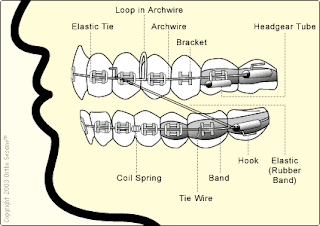Getting braces can feel overwhelming, but understanding the process and knowing what to expect makes your orthodontic journey much smoother. Whether you're considering braces for yourself or your child, this complete guide covers everything you need to know about achieving your perfect smile.
How Do Braces Work?
Braces apply gentle, consistent pressure to your teeth and surrounding bone structure. Over time, this pressure gradually moves your teeth into proper alignment. The process works because bone tissue naturally rebuilds itself when subjected to steady pressure, allowing your teeth to move into their ideal positions.
During treatment, you may need to wear rubber bands (elastics) between upper and lower brackets to assist with realignment. Some patients also require additional appliances like headgear for more complex corrections.
Types of Braces Available
Today's orthodontic patients have several options for straightening their teeth:
Traditional Metal Braces: The most common and cost-effective option, metal braces use brackets and wires to move teeth efficiently. Modern metal braces are smaller and more comfortable than ever before.
Ceramic Braces: Similar to metal braces but with tooth-colored brackets that blend with your natural teeth, making them less noticeable while maintaining effectiveness.
Invisalign: Clear aligners that are removable and virtually invisible. Invisalign works well for mild to moderate alignment issues and offers the convenience of removing trays for eating and cleaning.
Understanding Your Braces: Parts and Components

If you need to call Dr. Greenberg's office about any damage to your braces, we can help you more effectively if you can tell us exactly which piece needs attention. Here are the key components:
Brackets: Small attachments cemented directly to each tooth that hold the archwire in place.
Archwire: The main wire that acts as a track to guide teeth movement. It's changed periodically as teeth move to new positions.
Elastic Ties: Tiny rubber bands that fit around brackets to secure the archwire.
Bands: Thin metal rings fitted around teeth (usually molars) and cemented in place to anchor the braces system.
Elastics (Rubber Bands): Small rubber bands hooked between different points to provide additional pressure for specific tooth movements.
Additional Components: Your braces may include coil springs (to create space), hooks (for elastic attachment), tie wires (alternative to elastic ties), headgear tubes (for external appliances), and loops in archwires (for closing extraction spaces).
What to Expect During Treatment
Initial Appointment: Getting braces typically takes 1-2 hours. The process isn't painful, but you may experience some discomfort as your mouth adjusts to the new appliances.
Adjustment Visits: You'll visit our office regularly (usually every 4-8 weeks) for adjustments and progress monitoring. These appointments are crucial for ensuring your treatment stays on track.
Treatment Duration: Most patients wear braces for 18 months to 2 years, though complex cases may require longer treatment. Your cooperation with wearing elastics and following instructions significantly impacts your timeline.
Managing Discomfort and Care
Some soreness is normal, especially after getting braces and following adjustments. To manage discomfort:
• Rinse with warm salt water (1 teaspoon salt in 8 ounces water)
• Use orthodontic wax on brackets causing irritation
• Take over-the-counter pain relievers as needed
• Eat soft foods for the first few days
If wires become loose or brackets break, contact our office immediately. You can temporarily push loose wires back into place with a spoon handle or pencil eraser, and cover sharp edges with wax.
Foods to Enjoy and Avoid
Protecting your braces means making smart food choices to avoid treatment delays:
Avoid: Sticky foods (caramel, gum), hard foods (nuts, ice), crunchy snacks (popcorn, chips), and foods requiring biting (corn on the cob, whole apples).
Enjoy: Soft proteins (chicken, fish), dairy products, pasta, steamed vegetables, soft fruits, and treats like ice cream and smoothies.
Maintaining Excellent Oral Hygiene
Proper oral care is essential during orthodontic treatment. Poor hygiene can lead to permanent staining and decay around brackets:
• Brush after every meal with fluoride toothpaste
• Use interdental brushes or floss threaders for cleaning between brackets
• Rinse with an antimicrobial mouthwash
• Continue regular dental cleanings and checkups
Sports and Activities
You can continue playing sports with braces! We recommend wearing a protective mouthguard to prevent injury to your teeth and appliances. If you experience any damage during activities, contact our office immediately.
After Braces: Retainers
Once your braces are removed, you'll wear a custom retainer to maintain your new smile. Retainers are crucial for preventing teeth from shifting back to their original positions. Most patients wear retainers for at least two years, with many choosing to wear them indefinitely at night.
Ready to Start Your Orthodontic Journey?
Understanding what to expect makes the braces experience much more manageable. At our practice, we're committed to providing exceptional orthodontic care while ensuring you feel informed and comfortable throughout your treatment.
Ready to take the first step toward your perfect smile? Schedule a consultation with Dr. Greenberg to discuss your orthodontic options and create a personalized treatment plan that fits your needs and lifestyle.




